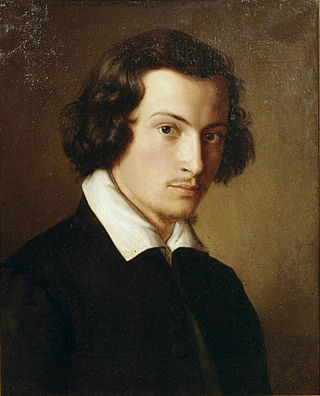
Philipp Veit was a German Romantic painter and one of the main exponents of the Nazarene movement. It is to Veit that the credit of having been the first to revive the nearly forgotten technique of fresco painting is due.

Max Liebermann was a German painter and printmaker, and one of the leading proponents of Impressionism in Germany and continental Europe. In addition to his activity as an artist, he also assembled an important collection of French Impressionist works.
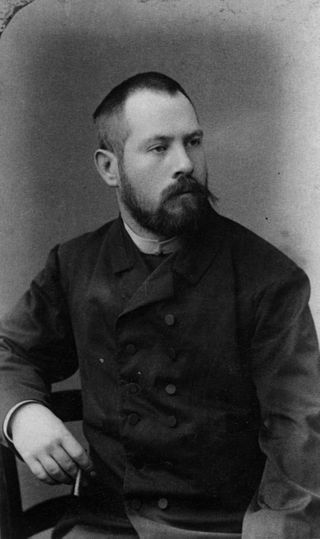
Lovis Corinth was a German artist and writer whose mature work as a painter and printmaker realized a synthesis of impressionism and expressionism.

Otto Müller was a German painter and printmaker of the Die Brücke expressionist movement.

Karl Christian Ludwig Hofer or Carl Hofer was a German expressionist painter. He was director of the Berlin Academy of Fine Arts.
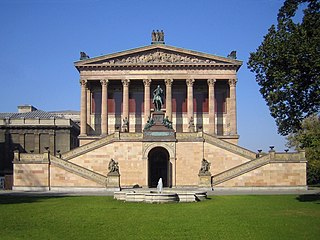
The Alte Nationalgalerie is a listed building on the Museum Island in the historic centre of Berlin, Germany. The gallery was built from 1862 to 1876 by the order of King Frederick William IV of Prussia according to plans by Friedrich August Stüler and Johann Heinrich Strack in Neoclassical and Renaissance Revival styles. The building's outside stair features a memorial to Frederick William IV. Currently, the Alte Nationalgalerie is home to paintings and sculptures of the 19th century and hosts a variety of tourist buses daily. As part of the Museum Island complex, the gallery was inscribed on the UNESCO World Heritage List in 1999 for its outstanding architecture and its testimony to the development of museums and galleries as a cultural phenomenon in the late 19th century.
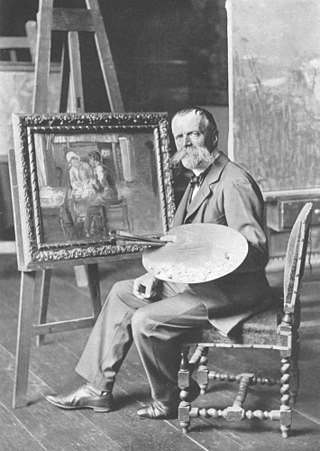
Fritz von Uhde was a German painter of genre and religious subjects. His style lay in-between Realism and Impressionism, he was once known as "Germany's outstanding impressionist" and he became one of the first painters to introduce plein-air painting in his country.
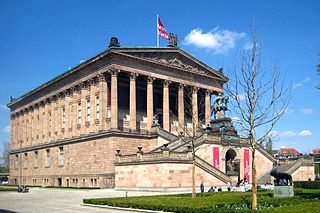
The National Gallery in Berlin, Germany, is a museum for art of the 19th, 20th and 21st centuries. It is part of the Berlin State Museums. From the Alte Nationalgalerie, which was built for it and opened in 1876, its exhibition space has expanded to include five other locations. The museums are part of the Berlin State Museums, owned by the Prussian Cultural Heritage Foundation.

Realism was an artistic movement that emerged in France in the 1840s, around the 1848 Revolution. Realists rejected Romanticism, which had dominated French literature and art since the early 19th century. Realism revolted against the exotic subject matter and the exaggerated emotionalism and drama of the Romantic movement. Instead, it sought to portray real and typical contemporary people and situations with truth and accuracy. It did not avoid unpleasant or sordid aspects of life. The movement aimed to focus on unidealized subjects and events that were previously rejected in art work. Realist works depicted people of all social classes in situations that arise in ordinary life, and often reflected the changes brought by the Industrial and Commercial Revolutions. Realism was primarily concerned with how things appeared to the eye, rather than containing ideal representations of the world. The popularity of such "realistic" works grew with the introduction of photography—a new visual source that created a desire for people to produce representations which look objectively real.
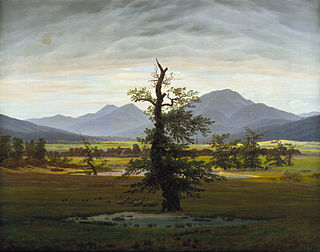
The Lonely Tree is an 1822 oil-on-canvas painting by German painter Caspar David Friedrich. It measures 55 × 71 centimetres (22 × 28 in). The work depicts a panoramic view of a romantic landscape of plains with mountains in the background. A solitary oak tree dominates the foreground.

Moonrise by the Sea or Moonrise over the Sea is an 1822 oil-on-canvas painting by German painter Caspar David Friedrich. The work depicts a romantic seascape.

The Watzmann is an 1824-1825 oil on canvas painting by Caspar David Friedrich, showing the Watzmann mountain as seen from Berchtesgaden to the north-east. It is now on display in the Alte Nationalgalerie in Berlin.

The Interior of the Palm House on the Pfaueninsel Near Potsdam, commonly shortened to The Interior of the Palm House or The Palm House, is the title of two paintings in oil on canvas by Carl Blechen. Both depict four odalisques as they relax in a palm house at the royal retreat of Pfaueninsel, though the angles of view and compositions are different. The first to be painted, in 1833, is now in the Hamburger Kunsthalle in Hamburg, Germany, and has a size of 64 cm × 56 cm. The second version, from 1834, is now in the Art Institute of Chicago, measuring 135 cm × 126 cm. An 1832 color study for the painting is also in the collection of the Alte Nationalgalerie in Berlin.

The Balcony Room is an oil-on-canvas painting by the German artist Adolph Menzel, executed in 1845. It is one of the main works of his early period and one of his most famous paintings. It has belonged to the collection of the Alte Nationalgalerie in Berlin, since 1903.

Female Half-Length Nude with Hat is an oil-on-canvas painting by German artist Ernst Ludwig Kirchner, executed in 1911. It his held at the Museum Ludwig in Cologne.

The Iron Rolling Mill (Modern Cyclopes) is an oil on canvas painting by German artist Adolph Menzel, created in 1872-1875. The painting is one of his main works from the time when the painter was mostly concerned with contemporary issues and the social question as a result of the uninhibited technical advances made during the Industrial Revolution, particularly in Germany. It has the large dimensions of 158 by 254 cm. The signature of the artist can be seen at the lower left: "Signatur Adolph Menzel. Berlin 1875". The realistic painting caused a stir at the time and is now part of the collection of the Alte Nationalgalerie, in Berlin.
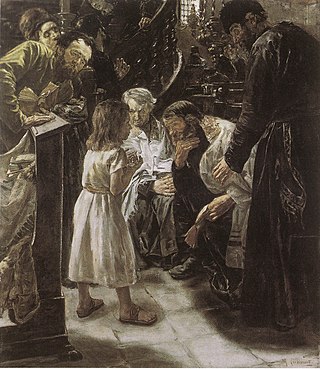
The Twelve-Year-Old Jesus in the Temple is an oil-on-canvas painting by German painter Max Liebermann, created in 1879. It is held at the Hamburger Kunsthalle.

Portrait of the Painter Lovis Corinth is an oil-on-canvas painting by the German painter Max Liebermann, created in 1899. It depicts fellow German painter Lovis Corinth in a half-length portrait. The painting is in the possession of the Deutsche Bank, in Frankfurt.
Julius Bernhard Stern was a German Jewish banker, art collector and philanthropist.

Country House in Hilversum is an oil on canvas painting by the German painter Max Liebermann, from 1901. The painting shows a villa in a park near the Dutch town of Hilversum. It is signed "M.Liebermann" at the bottom left. It is part of the collection of the Alte Nationalgalerie, in Berlin.



















